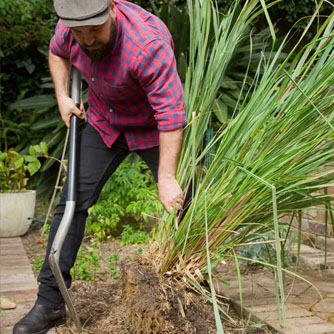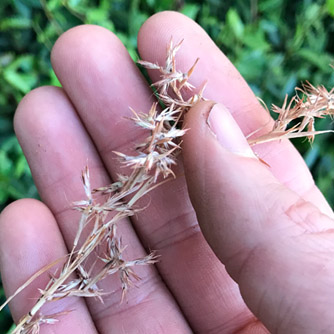Lemongrass
BackLemongrass is a wonderful herb used to add a zesty, citrus flavour to many Asian soups and stir fries. It grows into a lovely arching grass clump that looks great in many garden locations not just the herb patch. It also makes a great pot plant and will thrive on a warm balcony. A word of warning though – the leaves have sharp edges and should be handled with care.
There are two common types of lemongrass which are native to the Indian and southern Asian regions:
- West Indian Lemongrass (Cymbopogon citratus) is the more commonly used type for cooking (chopped/crushed stalks), in teas (leaves) and in perfumes. It grows easily in any warm climate and gets up to 90cm.
- East Indian Lemongrass (Cymbopogon flexuosus) grows taller (up to 1.5m), has purple tinges to the stems and prominent pinkish/purplish seed heads. Can be used in cooking and teas.

Mature lemongrass clump
How To Grow & Maintain Lemongrass
Ideally lemongrass prefers regions with warm, dry winters and hot, wet summers but it does readily grow outside of these conditions eg as far south as Melbourne and inland Australia. It will need protection from frost in these areas so choose a sheltered location or grow in a pot which can be moved around.Lemongrass can handle a wide range of soils but prefers rich, free draining soils where possible. Improve poor soils with compost and manures for better growth. Use gypsum to improve drainage in clay soils.
Lemongrass should receive at least half a day of full sun and is drought tolerant once established.
Lemongrass can be grown from seed, established plants or division of an existing clump. Seed should be sown in spring into punnets and watered in with OCP eco-seaweed. Seeds will germinate in 14-25 days. Transfer strong seedlings into individual small pots and grow them on until about 15-20cm high. At this stage they can be planted into the garden or a large pot. Alternatively, young plants can be bought from nurseries almost year round but will establish faster if planted in spring or summer.
Division of an existing clump is best done in spring. You can either dig up the entire clump before splitting into smaller sections or just slice off a side section. Lemongrass is pretty tough but with either method be sure to keep a decent amount of roots with each section. Remove any dead leaves/stalks and cut remaining stalks to about their half height. Settle your plant in with a good watering of OCP eco-seaweed.

Lemongrass stalks ready to use in cooking
For the best ongoing growth keep plants well watered throughout the summer and nourish with applications of OCP eco-seaweed and OCP eco-aminogro every 2-4 weeks.
If your clump gets messy and overgrown it can be cut back hard in late winter and fresh new growth will appear in spring. In colder areas there may be some browning off in winter which should be left there until early spring when it can be cut back to make way for new shoots as the weather warms up. Do not over water in winter.
Harvesting Lemongrass
For cooking purposes remove the whole stalk from the main plant as it’s the white base of the stem that is used. Pull off one or two outer leaf layers and you’re good to start chopping! To make lemongrass tea cut off some of the green leaf ends but keep the main stalk on the plant. The green leaves can be cut into small pieces and steeped in hot water.
You can harvest lemongrass at any time of the year but keep in mind that most plant growth occurs during the warmer months. If you have a small plant go easy on the harvesting during winter as it will be some time before replacement growth occurs.

Lemongrass can be easily dug up and divided
Pest and Diseases of Lemongrass
Lemongrass does not have many problems but root rot can occur if plants are over watered. If necessary adjust your watering regime to keep plants drier in winter (especially in cooler areas). Check drainage and ensure there is good airflow around the plant.
Rust can be a problem on Cymbopogon citratus. Remove infected leaves and avoid wetting the leaves when watering. Applying OCP eco-seaweed will help reduce plant stress and boost defences. If necessary spray with an organic fungicide. Note that Cymbopogon flexuosus is resistant to rust.
Powdery mildew can sometimes be a problem and can be controlled with an organic fungicide.

Lemongrass seeds can be collected and sown


